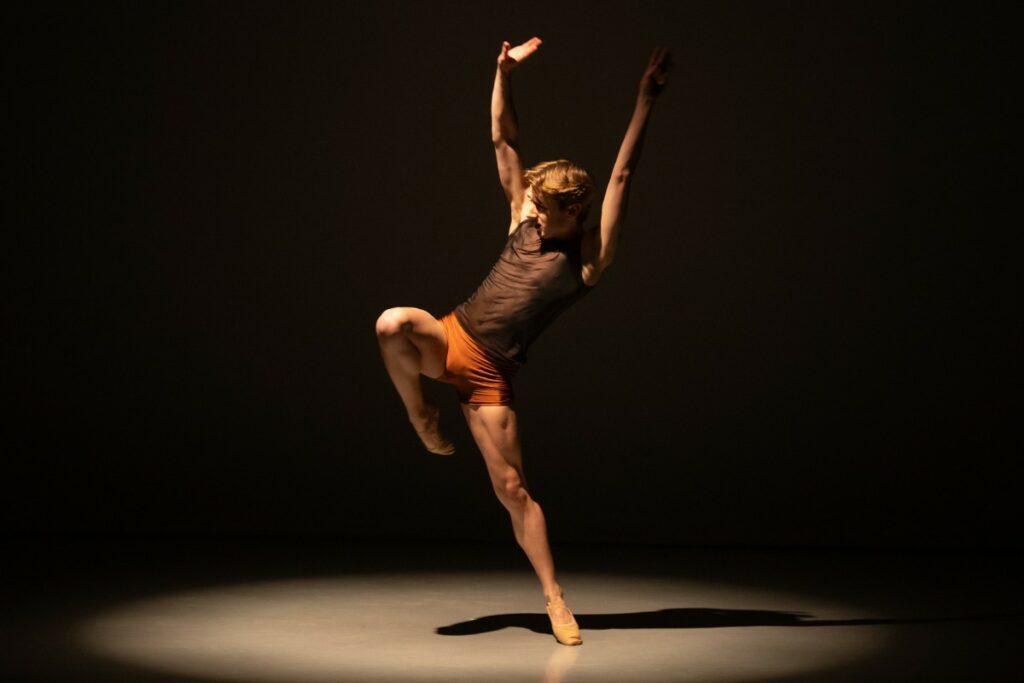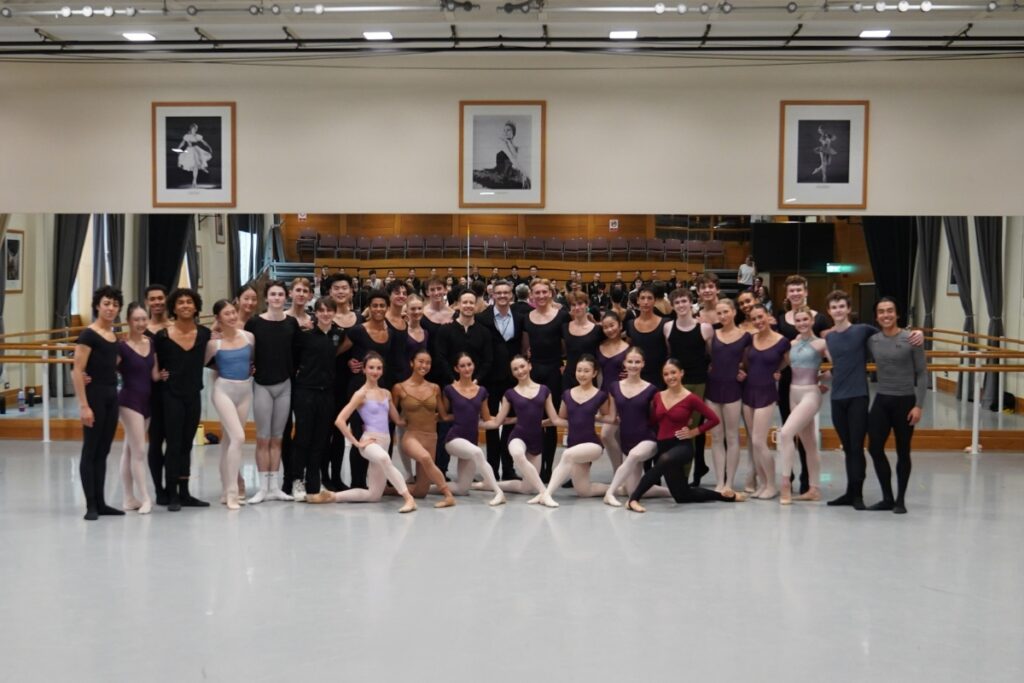The next generation of choreographers at Opera Holland Park
Each year, our Summer Performances repertoire includes a selection of student works originating from the Ninette de Valois Choreographic Programme. The programme gives students at different stages in the School an opportunity to create and stage their own pieces.
We sat down with three of our student choreographers, Tristan Ian Massa, Joe Parker and Soren Chisholm to learn more about their pieces and experience as student choreographers.
Our Special Waltz
Tristan Ian Massa, a 2nd Year student, created Our Special Waltz for this year’s Frederick Ashton Emerging Choreographer performance.
Can you tell us about your piece?
Tristan Ian: My piece reminds us that sometimes we take things for granted. One minute, something or someone is there, and the next, they could be gone. Personally, I haven’t experienced it too intensely, but I spoke to people who have. It’s a touching topic that many can relate to, and I wanted to translate it into movement. That’s my main inspiration.
What inspired this piece’s beginnings?
Tristan Ian: The music was a big inspiration. I chose it because it had a nostalgic feel, like a piano piece that sounds old. The song is Our Special Waltz by Lumas. I remember seeing a piece choreographed to it when I was younger, which might be why I picked it again.
What has it been like having it performed at Opera Holland Park?
Tristan Ian: It’s been amazing. I never thought I would get chosen to perform it here. At one point, I considered pulling out because I got injured and had no one to cover the piece. It’s been a surreal experience, and I’m grateful that people enjoy it and find it touching.
What has been the best part of seeing it on stage versus in rehearsals?
Tristan Ian: In rehearsals, it’s harder because the atmosphere is different. Seeing it on stage, in a new and different space, really brings the story together. It feels like watching a short film. I usually can’t see it from the outside, so I rely on others to film it and give me feedback. It seems like the essence is there, which makes me proud.
Do you think you will continue choreographing in the future?
Tristan Ian: I think I will. If you had asked me before this was picked, I might have said no because it was stressful. I initially did it to honour my eldest sister, who choreographed a piece when we were in school together. But now, looking at the final product, I really enjoyed the experience and would continue in the future.
What advice do you have for other students who want to get into choreography?
Tristan Ian: Finding inspiration is crucial as your first building block. Don’t feel pressured to make something drastically different. Something familiar that hasn’t been shown in dance can be very touching.


Our Special Waltz by Tristan Ian Massa
Who Knows the Dark?
Joe Parker, a 2nd Year student, created Who Knows the Dark? for our Frederick Ashton Emerging Choreographer this past year.
Can you tell us about your piece?
Joe: My piece is called Who Knows the Dark? It explores feelings of being lost in a situation that you have no control over. It was originally choreographed for the Frederick Ashton Emerging Choreographer. We worked on it from the beginning of September until the performances in May, maybe once or twice a week on Saturdays.
What inspired your choreography?
Joe: I was very much inspired by the music, which is very tactile. It has echoing voices in the background, asking questions. I also wanted to do a more contemporary piece but still incorporate pointe work and see how I could combine the two styles.
What has it been like having your choreography featured at Opera Holland Park and the Royal Opera House?
Joe: It’s been nice to see how it’s developed, the lighting, the big stage lights, and having it performed in front of an audience. It’s just a great feeling. All the hard work we’ve all put into it, not just me but also my dancers, is a great feeling.
The studio performances were nice, but the theatre lights in the Linbury did exactly what I wanted them to do. It had the right effect with all the side lights, creating a kind of liminal space, not grounding the dance in a specific area.
What has been the best part of seeing your choreography on stage?
Joe: Seeing everything with the lights and the costumes all together. Also, hearing the audience’s reactions and having that feedback at the end of the piece, hearing the audience react.
Due to one of my dancers being injured, I got a chance to perform in my piece, which has been nice because I created it in the style that I enjoy moving in. I’m trying to pass that on to the dancers. Being able to perform it is really fulfilling because I get to do the things that I created for an audience.
Do you think you will continue choreographing?
Joe: Yes, definitely. I’ve been choreographing and trying to make pieces all throughout White Lodge. In Years 10 and 11, my works were performed in the Kenneth MacMillan Emerging Choreographer performances, and I got the Kenneth MacMillan Choreographic Award in Year 10. However, due to COVID, nothing could be performed apart from the showcase. It was nice to create another piece last year, and then this year it will be performed. It’s just a big full circle, a really rewarding feeling.
What advice would you give to any fellow students who want to get into choreography?
Joe: Come into the room with lots of ideas. Nothing has to be set in stone. Be open to creating on the spot and listening to your dancers and feedback from others. If something isn’t working, allow yourself to change your idea or what you were planning to do. Don’t get stuck. You can always come back to it and change it later.


Who Knows the Dark? by Joe Parker
Symbiosis
Soren Chisholm, a Year 11 student at White Lodge, created Symbiosis for the Kenneth MacMillan Emerging Choreographer performance.
Can you tell us about your piece?
Soren: My piece is a portrayal of the relationship between the musician and the dancer. It shows the turmoil, the journey that they go on together as they create a piece. It’s split into three sections: the first section is very peaceful and thoughtful and then the second piece there’s a bit more turmoil, there’s a bit more anger, and the third piece is a resolution of that.
What has it been like having your choreography featured at Opera Holland Park?
Soren: It was a bit of a shock to start off with. Because it’s a duet, it’s quite difficult to fill such a big open stage. I think that was a big challenge, but seeing it for the first time on the big stage was incredible, and the dancers really stepped up to the task.
What has been the best part of seeing it on stage versus in rehearsals?
Soren: I think the jeopardy of it being on stage. In rehearsal, it’s just more relaxed, and there’s more freedom, but on stage, everyone’s a bit on their seat. It’s just nice to see how the dynamics change between that and how it brings out the extremities of the movement, that adrenaline.
Do you think you will continue choreographing?
Soren: I think I will. It was my fourth year choreographing, and this year has been an incredible learning curve. I’ve learned so much and working with the dancers, I felt my choreographic ability mature. I have so many more ideas, so many more things that I want to do.
What advice would you give to any fellow students who want to get into choreography?
Soren: I’d say just go for it. The biggest thing is you have to have an idea. I think it all stems from an idea. If you’re really passionate about the idea, then no matter what happens, as long as you always have passion and stay focused on that goal, that one idea, then you’ll be fine.
If it doesn’t stem from one idea, then it becomes just a dance—just movement. But if the dance has meaning and purpose, then it becomes choreography and a piece—a piece of art, which is what ballet is.


Symbiosis by Soren Chisholm





